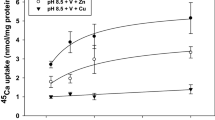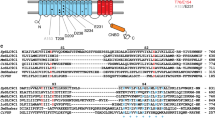Summary
Tetrahymena pyriformis cultivated in the presence of 1 mM taurine prior to transfer of the cells to non-nutrient medium express an enhanced capacity for concentrative taurine uptake and for taurine diffusion compared to cells grown without added taurine. The unidirectional taurine influx in taurine-grown cells comprises a saturable component with Km -257μM, Vmax = 21 n-moles · g dry wt−1 sd min−1, and a diffusion component with a diffusion constant of 0.20 ml · g dry wt−1 · min−1. At extracellular taurine concentrations <30μM, 20% of the influx is via the saturable system and 80% is via the diffusion system. 19% of the influx in Na+-dependent, Cl−-independent, and not inhibitable with structural analogues to taurine, suggesting that the transport system responsible for the saturable component in Tetrahymena is different from the Na+- and Cl−-dependent taurine translocating system (theβ-system) described in vertebrate cells. The unidirectional taurine influx is reduced by 80% by 1mM DIDS (inhibitor of anion exchange and anion channels) and by 1 mM MK196 (indachrinone, inhibitor of anion channels) indicating that taurine diffusion inTetrahymena is via a channel, which is permanently active and which resembles the swelling-induced “taurine channel” seen in mammalian cells. Taurine influx is stimulated by the forskolin analogue 1,9-dideoxyforskolin and by arachidonic acid, and this stimulation is in both cases sensitive to DIDS and MK196.
Similar content being viewed by others
Abbreviations
- DDF:
-
dideoxyforskolin
- DIDS:
-
4,4′-diisothiocyano-2,2′-stilbene disulfonic acid
- GABA:
-
gamma amino butyric acid
- HEPES:
-
N(2-hydroxyethyl)piperazine-N′-(2-ethane sulfonic acid)
- MK196:
-
indachrinone
- MOPS:
-
3-(N-morpholino)propane sulfonic acid
- NMDG:
-
n-methyl-dglucamonium
- OPA:
-
ortho-phtalaldehyde
- PCA:
-
perchloric acid
- TES:
-
N-tris(hydroxy methyl)-methyl-2-amino ethane sulfonic acid
- TRIS:
-
tris(hydroxy methyl)amino methane
References
Aomine M (1981) The amino acid absorption and transport in protozoa. Comp Biochem Physiol 68A: 531–540
Ballentine R, Burford DD (1960) Differential density separation of cellular suspensions. Anal Biochem 1: 263–268
Chabantchik ZI, Greger R (1992) Chemical probes for anion transporters of mammalian cell membranes. Am J Physiol 262: C803-C827
Connolly JG, Kerkut GA (1983) Ion regulation and membrane potential in Tetrahymena and Paramecium. Comp Biochem Physiol 76A: 1–16
Diaz M, Valverde MA, Higgins CF, Rucâreanu C, Sepúlveda FV (1993) Volume-activated chloride channels in HeLa cells are blocked by verapamil and dideoxyforskolin. Pflügers Arch 422: 347–353
Dunham PB, Kropp DL (1973) Regulation of solutes and water inTetrahymena. In: Elliott AM (ed) Biology ofTetrahymena. Dowden, Hutchinson, Ross, USA, pp 165–198
Hellung-Larsen P (1988) Parameters affecting the maximum cell concentration ofTetrahymena. Experientia 44: 58–60
Hill DL (1972) The biochemistry and physiology ofTetrahymena. Academic Press, New York London
Hoffmann EK, Kramhøft B (1969) A relationship between amino acid and sodium transport inTetrahymena pyriformis. Exptl Cell Res 56: 265–268
Hoffmann EK, Rasmussen L (1972) Phenylalanine and methionine transport inTetrahymena pyriformis. Characteristics of a concentrating, inducible transport system. Biochim Biophys Acta 266: 206–216
Huxtable RJ (1992) Physiological actions of taurine. Physiol Rev 72: 101–163
Kaya K, Sano T (1991) Definition of total biosynthesis pathway of taurolipids inTetrahymena cells. Biochim Biophys Acta 1084: 101–104
Kaya K, Uchida K, Kasumi T (1985) Identification of taurine-containing lipid inTetrahymena pyriformis NT-1. Biochim Biophys Acta 835: 77–82
Keogh DP, Mitchell MJ, Crooks JR, Smith SL (1992) Effects of the adenylate cyclase activator forskolin and its inactive derivative 1,9-dideoxyforskolin on insect cytochrome P-540 steroid hydroxylase activity. Experientia 48: 39–41
Kirk K, Kirk J (1993) Volume-regulatory taurine release from a human lung cancer cell line. Evidence for amino acid transport via a volume activated chloride channel. FEBS Lett 336: 153–158
Kramhøft B, Jessen F (1992) Acid extrusion by the ciliate protozoanTetrahymena pyriformis, and activation of a quiescent Na+/H+ exchanger by CuSO4. Cell Physiol Biochem 2: 8–17
Kramhøft B, Lambert IH (1995) Taurine uptake under starvation conditions by the protozoanTetrahymena pyriformis. Amino Acids 9: 81
Lambert IH (1984) Na+-dependent taurine uptake in Ehrlich ascites tumour cells. Mol Physiol 6: 233–246
Lambert IH (1985) Taurine transport in Ehrlich ascites tumour cells: specificity and chloride dependence. Mol Physiol 7: 323–332
Lambert IH, Hoffmann EK (1994) Cell swelling activates separate taurine and chloride channels in Ehrlich mouse ascites tumor cells. J Membrane Biol 142: 289–298
Laurenza A, Sutkowski EM, Seamon KB (1989) Forskolin a specific stimulator of adenylyl cyclase or a diterpene with multiple sites of action? TIPS Rev 10: 442-447 Mollerup J, Lambert IH (1996) Phosphorylation is involved in the regulation of the taurine influx via theβ-system in Ehrlich ascites tumor cells. J Membrane Biol 150: 73–82
Ramanathan S, Chou SC (1973) Cyclic nucleotide phosphodiesterase fromTetrahymena. Comp Biochem Physiol 46B: 93–97
Saidha T, Stern AI, Schiff JA (1993) Taurine conjugates in the lipid fraction ofEuglena cells and their mitochondria. J Gen Microbiol 139: 251–257
Scherbaum OH, James TW, Jahn TL (1959) The amino acid composition in relation to cell growth and cell division in synchronized cultures of Tetrahymena pyriformis. J Cell Comp Physiol 53: 119–137
Shalinsky DR, Heath DD, Jehunen AP, Alcaraz JE, Howell SB (1993) Selective modulation of vinblastine sensitivity by 1,9-dideoxyforskolin and related diterpenes in multidrug resistant tumour cells. Br J Cancer 67: 471–479
Strange K, Jackson PS (1995) Swelling-activated organic osmolyte efflux: new role for anion channels. Kidney Intern 48: 994–1003
Wheatly DN, Rasmussen L, Tiedtke A (1994) Tetrahymena: a model for growth, cell cycle and nutritional studies, with biotechnological potential. BioEssays 16: 367–372
White G, Li C, Ishac E (1992) 1,9-dideoxyforskolin does not mimic all CAMP and protein kinase A independent effects of forskolin on GABA activated ion currents in adult rat sensory neurons. Brain Res 586: 157–161
Author information
Authors and Affiliations
Rights and permissions
About this article
Cite this article
Kramhøft, B., Lambert, I.H. Taurine transport systems in the ciliate protozoanTetrahymena pyriformis . Amino Acids 12, 57–75 (1997). https://doi.org/10.1007/BF01373427
Received:
Accepted:
Issue Date:
DOI: https://doi.org/10.1007/BF01373427




